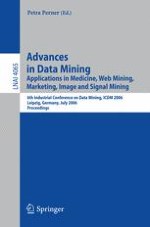The Industrial Conference on Data Mining ICDM-Leipzig was the sixth event in a series of annual events which started in 2000. We are pleased to note that the topic data mining with special emphasis on real-world applications has been adopted by so many researchers all over the world into their research work. We received 156 papers from 19 different countries. The main topics are data mining in medicine and marketing, web mining, mining of images and signals, theoretical aspects of data mining, and aspects of data mining that bundle a series of different data mining applications such as intrusion detection, knowledge management, manufacturing process control, time-series mining and criminal investigations. The Program Committee worked hard in order to select the best papers. The acceptance rate was 30%. All these selected papers are published in this proceedings volume as long papers up to 15 pages. Moreover we installed a forum where work in progress was presented. These papers are collected in a special poster proceedings volume and show once more the potentials and interesting developments of data mining for different applications. Three new workshops have been established in connection with ICDM: (1) Mass Data Analysis on Images and Signals, MDA 2006; (2) Data Mining for Life Sciences, DMLS 2006; and (3) Data Mining in Marketing, DMM 2006. These workshops are developing new topics for data mining under the aspect of the special application. We are pleased to see how many interesting developments are going on in these fields.
